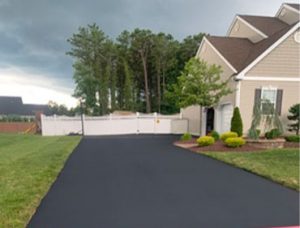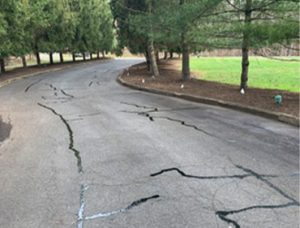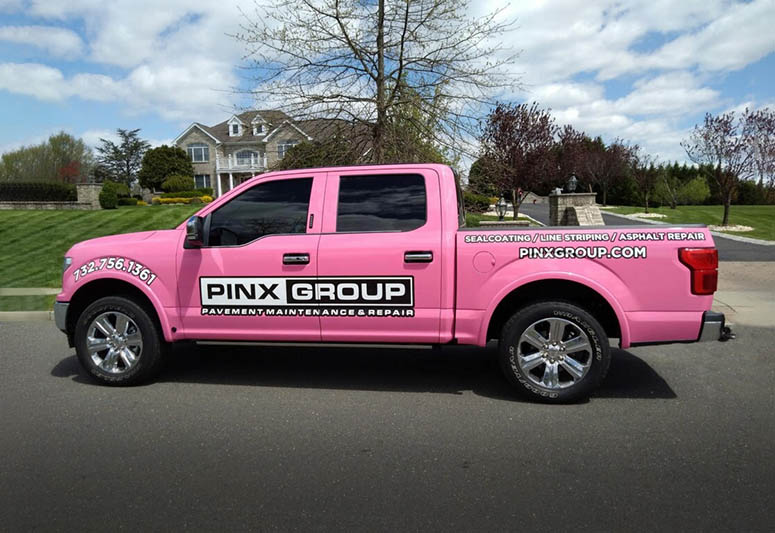Asphalt Maintenance Questions
These are answers to many of the questions people frequently ask about asphalt, asphalt paving, sealcoating, parking lot striping, and all of the other work we do for your paving.
What is Sealcoating? 
Sealcoating is a process of putting a protective coating on top of your asphalt pavement, it is not only a process we are proud of doing well at Pinx Group, but one we have delivered flawlessly to our asphalt clients throughout the New Jersey Metro Area for years.
Why Seal coat your parking area or Driveway?
Just like changing the oil in your car your asphalt needs its top layer of oil replaced in order to prolong its life. Some customers use Sealcoating purely to beautify their asphalt pavement. While other clients utilize the preventative maintenance benefits to extend the life of their asphalt. Whatever your asphalt sealcoating needs, Pinx Group is best placed to offer you the right treatment for your asphalt for the right price.
When new asphalt paving is put in, the asphalt should cure for at least 3 months in 60 degree weather or warmer to release excess oils from the asphalt and harden the paving properly. If the asphalt is not properly sealed after curing, the asphalt paving will begin to over-cure and lose the essential oils that keep it flexible. We usually recommend customers wait until the following season with new asphalt.
One of the main benefits is extending the life of your pavement by slowing down the natural deterioration process UV rays from the sun break down the glue portion of asphalt, making it brittle and causing the small stones on the surface to become loose and pop. In these areas, water can freeze and thaw in the winter and cause additional cracking and deterioration. Sealers from Star Seal are of the highest quality and help extend your asphalt’s life, protect your investment and enhance the beauty of your driveway or parking lot.
Sealcoating slows down this process, thereby enhancing the life of your asphalt. Another main benefit is improving curb appeal. Your asphalt investment is one of the greatest assets of a property both financially and in physical appearance. Pinx Group are expert Sealcoaters and can make the first impression on your paving a positive one!
What is our sealer made of and why?
- Coal tar: inherently resistant to thermal and UV oxidation, erosion caused by moisture, gasoline and oil drippings, salt.
- Clay: makes sealer cure hard, improves wear, diminishes risk of tracking.
- Aggregate (silica sand): increases skid resistance, wear, minimizes slipping on your asphalt.
- Latex Additive improves suspension of sand in sealer, wear, resistance to scuffing and power steering marks on your paving, improves bonding to asphalt, makes sealer blacker and provides additional oil, water and UV resistance for your asphalt paving.
A Small Amount of Sealer Got On My Lawn. Will this kill my grass?
No, any sealer which might have inadvertently got on your grass will not kill it and should disappear within the next time or two your lawn is mowed.
How often and when should you Seal?
Pinx Group has clients that receive sealcoating yearly, whilst we also have clients that come back for sealcoating work every 4 years on their asphalt. We recommend sealing asphalt every 1-3 years so that sealer can properly wear down before re-coating. Often sealcoating is necessary before the previous coat has worn down because of the amount of cracks in the paving and deterioration of the asphalt. Sealer should not be applied when ambient temperatures are below 45 degrees Fahrenheit.
What About Crack Repair? 
Cracks should be filled at every sealcoating and often have maintenance between years to help battle mother nature’s freeze and thaw of winter water. Larger cracks are a major cause of deterioration and costly asphalt repair. Many sealing contractors fill very few cracks or none at all (not Pinx Group!!)—a crack fill and sealant program can triple the life of asphalt compared to unsealed asphalt pavement. Sealcoating is not a substitute for crack filling.
Oil Spots?
Large oil and gas spots should be cleaned with a wire brush or burned off. We use a spot sealer that promotes adhesion between sealer and pavement on tough oil spots—many companies don’t even know what this product is!
Do Asphalt Sealers Sealcoat in the Rain?
No. Pavement temperature, precipitation, wind and humidity can all adversely affect the sealcoating project. We carefully monitor the weather and update our customers accordingly.
Application Method?
The number of coats are not as important as the rate of application and mix design—sealer applied to asphalt improperly, or mixed cheaply, regardless of the number of coats will not last longer. Our mixes are designed and are specified for high traffic use, like a parking lot. We offer multiple application options depending on the condition and size of the asphalt. From broom coating (mainly residential and smaller commercial parking lot) to double coat spray application, to spot seal broom and subsequent spray application—whatever best fits your project and budget.
Do all Asphalt Paving Contractors Use the same Seal coat?
No. It is very important to check with your contractor and ensure they use additives and sand with their sealer. Pinx uses only Star Seal, which is a superior product. Without appropriate amounts of sand, the material can not give enough traction on the asphalt and by using high-quality additives such as latex the strength and longevity of the Sealcoating can be greatly enhanced.
Why are some Sealcoating Quotes much Lower than Others?
Beware of “low-ball” proposals from a contractor and compare apples to apples. It is important to ask that your asphalt paving contractor is both licensed and insured. It is also important to know that they can be trusted to use the correct mix design with their Sealer. Untrustworthy contractors have been known to water down their Sealcoating mix, thereby enabling a cheap quote that looks good on paper but is a maintenance project that won’t last.
Pinx Group has been around for 15 years because our customers trust us to deliver them a high-quality product at a fair price. All sealer is not the same! Choose a Pinx contractor if you want the best advice, work, service and product in the industry! Contact us today! We are always happy to answer anything you ask about asphalt, concrete and paving!
Will Having Crack Filling Done Make the Cracks in My Asphalt Pavement Disappear?
No. Crack Filler is a thicker material and will be visible even when the crack repair is covered with sealcoating. Despite the crack repair being visible, it is still the number one thing you can do to prolong the life of your asphalt. Untreated cracks frequently turn into larger cracks and potholes in your asphalt paving and lead to further deterioration.
How Are Cracks in Asphalt Repaired ?
While we understand that property owners and managers may want to attempt to repair asphalt themselves to save money, we strongly suggest you first consult a professional asphalt pavement maintenance company. To ensure the crack is filled or sealed properly, it’s important to not take any shortcuts or skip steps. First, the crack is cleaned out of any loose gravel, debris, or weeds, and any broken chunks or loose pieces of asphalt are removed. For smaller cracks, the crack sealer is carefully poured into the crack and a roller goes over to smooth out the sealant. Deeper cracks repaired with a hot filler are repaired in a similar fashion. The area is cleaned out thoroughly of any dirt and debris, but to ensure the filler adheres properly, a tack coat may need to be applied. This is often only used in the most severe asphalt cracks. After the tack coat is applied and cures for a few moments, an asphalt repair contractor will use a machine to heat the emulsion and install it into the cracks, filling the area. Then the mixture is smoothed out to ensure an even asphalt surface.
After the crack is filled a sealcoat can be applied to the asphalt to protect the area from water, UV rays, and other things that may dry out the rubber or asphalt and possibly cause the crack to return sooner.
- Cost-Effective: Crack filling decreases the cost to maintain asphalt in the long-run.
- Crack filling also offers a low average investment that is ultimately 20 to 30 times less expensive than replacing neglected asphalt.
- Durable: Crack filling extends asphalt paving life.
- Attractive: Crack filling enhances the safety and appearance of your parking lot asphalt, ensuring your customers and employees remain happy and unharmed.
- Water-Resistant: Crack filling prevents further asphalt damage by limiting water from penetrating the asphalt surface.
We can apply crack filler to nearly any asphalt surface including roads and highways, parking lots and airport runways.
What Happens If You Don’t Fill Cracks in Asphalt Paving?
Small to medium-sized asphalt cracks are generally not going to affect driving conditions, but it’s still essential they are repaired. If damaged asphalt is ignored, water, temperature changes, and all of the factors that led to the asphalt crack in the first place will cause additional asphalt deterioration, including larger cracks, crumbling sections and pot holes. These are not just expensive and time-consuming to fix, they can lead to additional liability such as accidents, vehicle damage, and injury.
Why didn’t you fill every Crack in this particularly bad Area?
Too much crack filler in one parking area will cause the product, as well as chunks of asphalt, to be ripped up when driven over. To prevent this, we fill the outermost cracks of the bad area as well as a few in the center. This process is called containing and seeks to prevent those cracks from spreading to other areas of the asphalt paving.
Why Maintain Your Parking Lot Markings?
The number one benefit of making sure your parking lot is clearly striped is for safety and convenience of the people using it. Parking space lines and direction arrows ensure a safer, more organized driving and parking experience for residents and visitors on your parking lot. If the parking lot lines aren’t visible and an accident or damage to a vehicle occurs on your lot, you may be held liable. Additionally, clean, clear lines simply look better, and improving your exterior parking lot appearance will make a better impression and attract more people to your property.

How often should I paint new striping?
In higher traffic areas (such as fast-food drive-throughs, asphalt roadways or shopping mall parking lot), new stripes are traditionally painted every year. For moderate to low traffic areas, striping parking lot work may last 2-3 years.
What should I expect from new stripes?
Customers using Pinx Group to apply new paint can expect a high-quality application and clean, straight, smooth lines that will improve the overall aseptic of your parking lot.
What if I want to change my existing parking layout?
If you would like to change your lot layout, Pinx can help you both modify or completely redesign your parking lot areas. Stripes can be ground out, blacked out, painted over, painted a different color, etc. and your surfaces will still look good. After sealcoating is a particularly good time to make changes to your parking lot layout. Existing lines can be painted over or ground away, the sealer applied, and new striping completed for your parking lot.
What do I need to do to prepare for Striping?
Simply arrange a time for us to come when there are no cars in the way and minimal vehicular or pedestrian traffic. Preparing a parking lot for new line striping is half the battle. First, the weather must be taken into consideration. The line striping project should be scheduled during dry weather. Not only does the area need to be dry when the paint is being applied, but it’s also important to avoid precipitation for at least four hours after re-striping.
How long will my business be interrupted for striping?
With proper planning, there should be minimal business parking lot interruption. It takes anywhere from 20-60 minutes (depending on temperature and other factors) for the paint to dry. We work 7 days a week, including early mornings.
How important is the actual layout of the parking lot asphalt?
You can benefit from our years of experience to ensure you get the maximum number of parking lot spaces, the traffic flow is efficient, and you meet applicable safety laws. Plus, it will make both your asphalt paving areas (and you) look great.

Hopefully, we have answered all of your questions about asphalt, paving, maintenance, services asphalt repair, services asphalt paving, parking lot paving, lot striping parking areas, sealcoating parking lot and all of the asphalt installation questions you would have for your New Jersey asphalt contractor. If not, feel free to contact us and ask any additional asphalt or paving questions you may have.